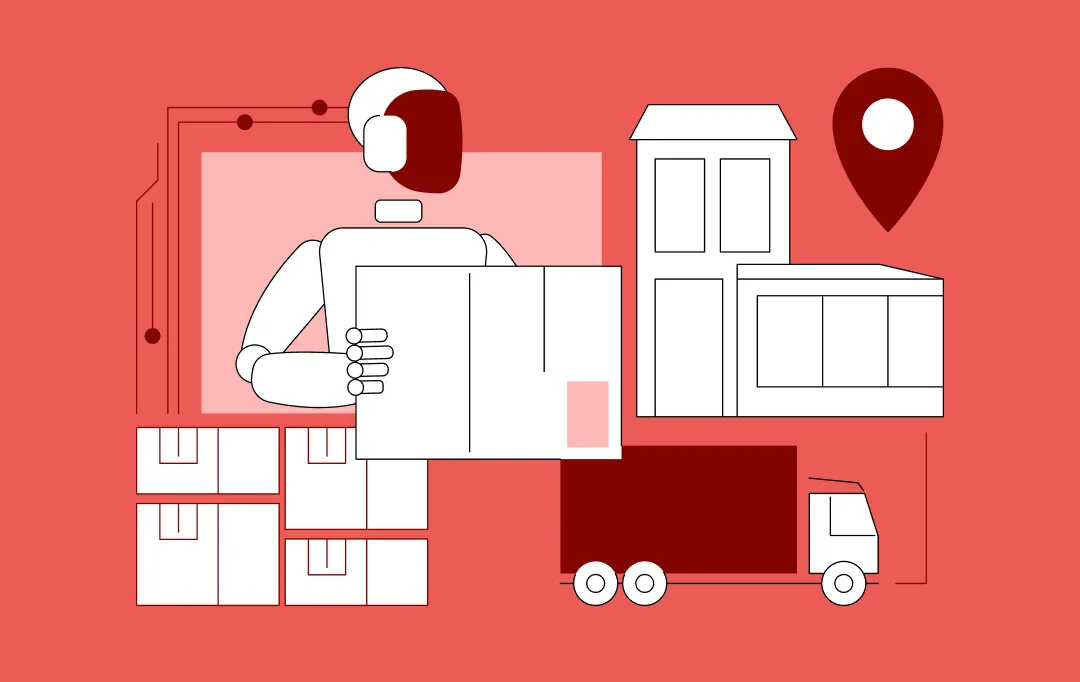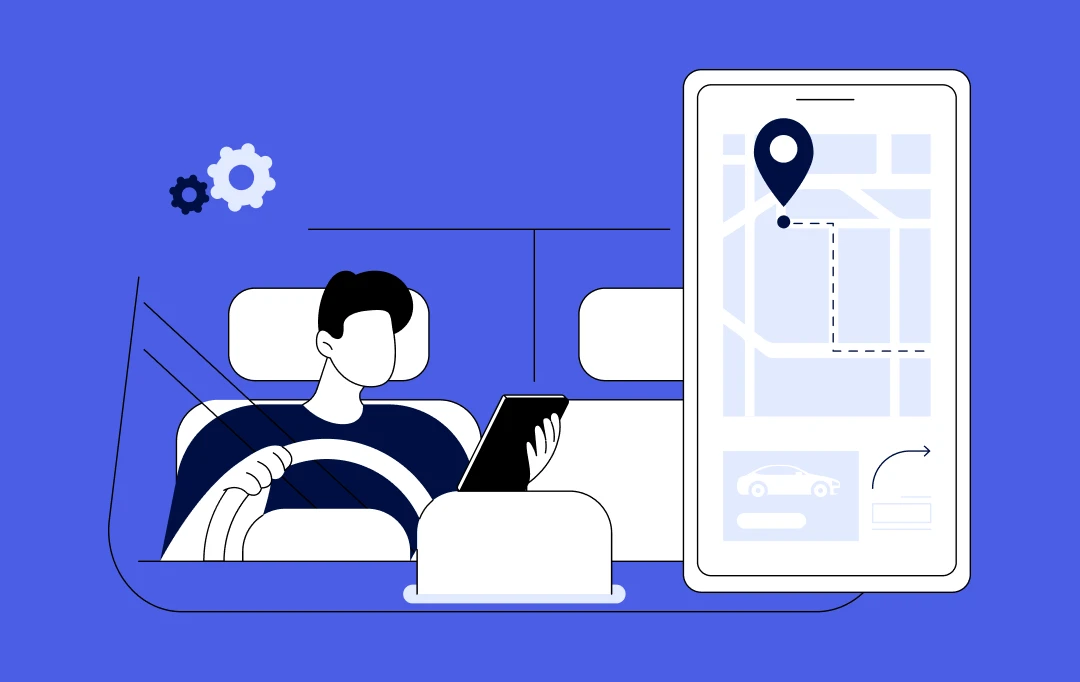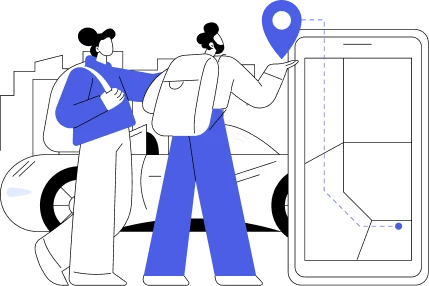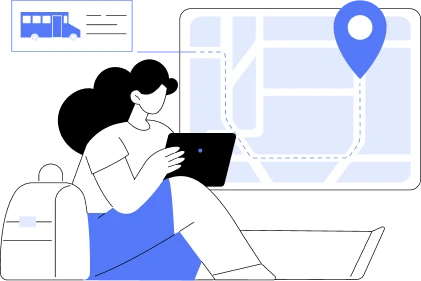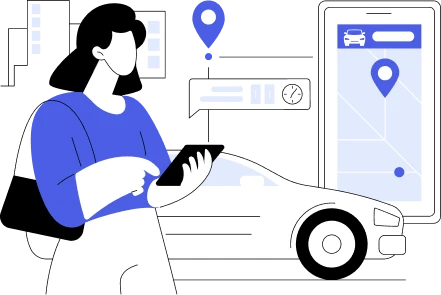- Overview of the Komoot App
- Market Landscape & Demand Drivers for the Cost to Build App Like Komoot in Europe
- Why It Stands Out in the Market
- Market Performance
- A Comprehensive View of the Cost to Build an App Like Komoot
- Route Planner App Development Cost breakdown by Complexity Levels
- Cost Breakdown by Development Stages
- Estimating the Cost
- Cost Estimation Formula
- Factors Affecting Cost to Build a Route Planning App Like Komoot
- 1. Complexity of Design
- 2. Complexity of Backend Development
- 3. Third-Party Integrations
- 4. Security Measures
- 5. Compliance Measures
- 6. Platform Selection
- 7. Technologies Used
- 8. Complexity of Features
- Key Features of Route Planning App Like Komoot
- Hidden Costs to Build an App like Komoot
- 1. App Maintenance
- 2. App Hosting
- 3. App Promotion and Marketing
- 4. Legal and Licensing Fees
- Ways to Optimize Komoot-like App Development Costs
- 1. Developing an MVP
- 2. Leveraging Cross-Platform Development
- 3. Outsourcing to Cost-Effective Regions
- Steps to Build an App like Komoot
- 1. Discovery & Market Research
- 2. UX & UI Design
- 3. Architecture & Backend Development
- 4. Frontend & Mobile Development
- 5. Testing, QA & Compliance
- 6. Deployment & Post-Launch Support
- Best Ways to Make an App Better than Komoot
- UI/UX Enhancements
- 2. Feature Enhancements
- 3. Technological Advancements
- How Appinventiv Built an App Like Komoot
- Solutions and Services Offered
- Results Achieved
- Monetization Strategies for Route Planner App Development
- Freemium Model with Regional Unlocks
- Subscription-Based Access
- Strategic Partnerships and B2B Collaborations
- Contextual, GDPR-Compliant Advertising
- Marketplace Model
- How to Choose the Right Partner to Build App Like Komoot Cost in Europe
- Why Partner with an App Development Company like Appinventiv
- FAQs
- Q. How much does a Komoot-like app cost to build?
- Q. How long does it take to build an app like Komoot?
- Q. What advantages come with developing an app similar to Komoot?
- Q. Why should you choose us to build an app like Komoot?
- Q. How can you monetize an app like Komoot?
- Q. What factors influence the cost of building a route planning app?
- Q. What features add to the cost of route planner app development?
- Q. Where can I find affordable route planning app developers in Europe?
Europe doesn’t just love the outdoors- it thrives on it. From the Alps to Amsterdam’s bike lanes, cycling and hiking fuel an industry worth $53.3 billion in 2024, projected to grow at nearly 11% CAGR through 2033, as reported by GrandViewResearch. And leading this charge is Komoot, the route-planning app trusted by 40+ million users.
But here’s the real conversation for businesses- building a Komoot-level app isn’t just about adding flashy features. It’s about owning the total cost of success- designing an offline-first, GDPR-compliant routing stack that works flawlessly across languages, regions, and user expectations.
So, what’s the real cost to build an app like Komoot in Europe? The answer isn’t only about dollars or euros. It’s about the cost of under-delivery- churn, compliance risks, and lost market share if your app can’t meet EU-grade standards.
For context: a lean MVP can start at $30k (€25.5k–34k), while a fully scalable, enterprise-ready solution can climb to $400k (€340k+), depending on vision and complexity.
This guide is your blueprint to making the right calls- phasing investment smartly, proving ROI early, and scaling confidently in Europe’s booming outdoor market. Let’s dive in!
Overview of the Komoot App
Komoot is far more than a navigation app. It has established itself as the best outdoor route planning app in Europe, attracting both experienced hikers and adventure seekers as well as recreational bikers. Its winning recipe blends unique USPs, community-driven features, and cutting-edge technology.
Also Read: A Comprehensive Guide on Building Waze Navigation App
Market Landscape & Demand Drivers for the Cost to Build App Like Komoot in Europe
The European outdoor navigation app market is thriving. Eurostat and McKinsey project double-digit growth in cycling tourism and outdoor recreation over the next few years. Meanwhile, EU-backed initiatives like the European Declaration on Cycling encourage sustainable transport and investment in digital mobility. For entrepreneurs, this makes Europe a highly attractive market for launching a Komoot-like app.
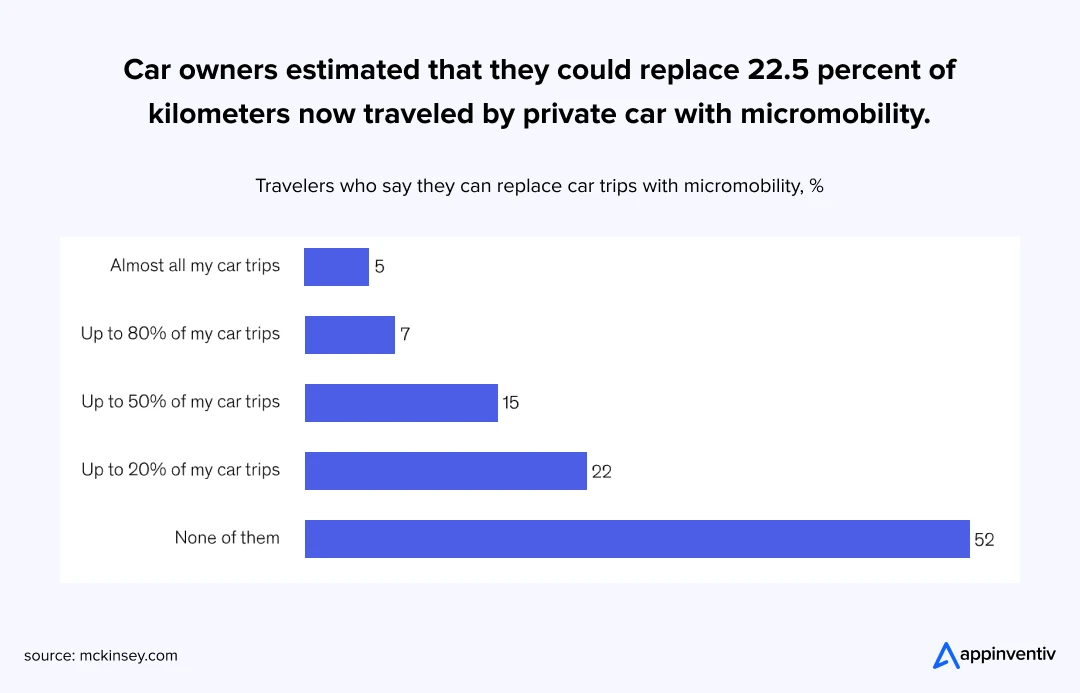
Why It Stands Out in the Market
- Offline-First Navigation: Necessary for remote areas with poor connectivity.
- Multi-Activity Support: Personalised routes for cycling, hiking, MTB, and trail running.
- Community Features: GPX tracks, reviews, and highlights enrich the app’s knowledge base.
- Premium Region Unlocks: The pay-per-region concept is appropriate for the varied travel culture of Europe.
- GDPR compliance: In accordance with EU requirements, GDPR-compliant navigation apps place a high priority on privacy and data protection.
Market Performance
With more than 40 million users, Komoot dominates Europe’s route planning ecosystem. It drives significant value for the cycling tourism and outdoor recreation industries, both projected to expand rapidly. Komoot’s advantage lies in user participation, personalized routing, and community-driven trust, setting it apart from generic navigation tools.
A Comprehensive View of the Cost to Build an App Like Komoot
Building a superior route planning tool, such as Komoot, has several cost layers that are impacted by feature complexity, development stages, and local developer costs. By being aware of these costs, companies can avoid unforeseen budget overruns and make prudent investment decisions.The route planner app development pricing in Europe is listed below:
Route Planner App Development Cost breakdown by Complexity Levels
The cost to develop a route planning app like Komoot can be categorized into three tiers based on the overall complexity level, including features, tech stack, team size, and timeline:
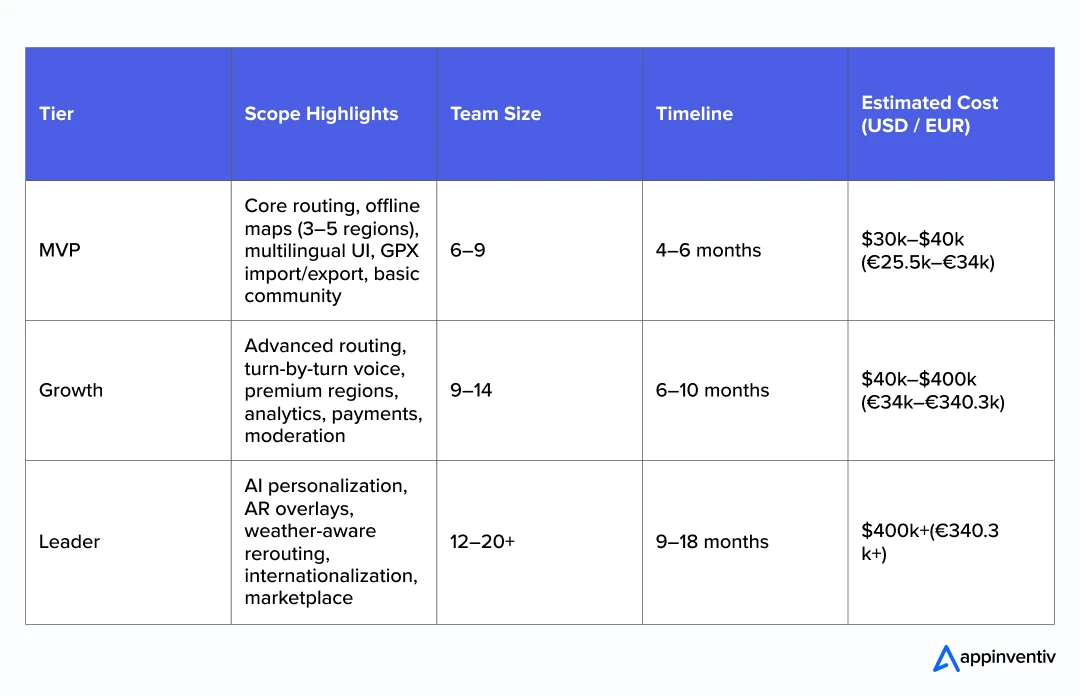
The complexity level directly impacts development hours, testing effort, and infrastructure needs, making it the largest driver of the cost to build an app like Komoot.
Cost Breakdown by Development Stages
When developing a route planning app, such as one similar to Komoot, the overall cost is influenced by the various stages of development. Each stage contributes to the final budget, depending on the complexity, scope of features, and the resources required. Here is the detailed breakdown of Route Planner App Development cost:
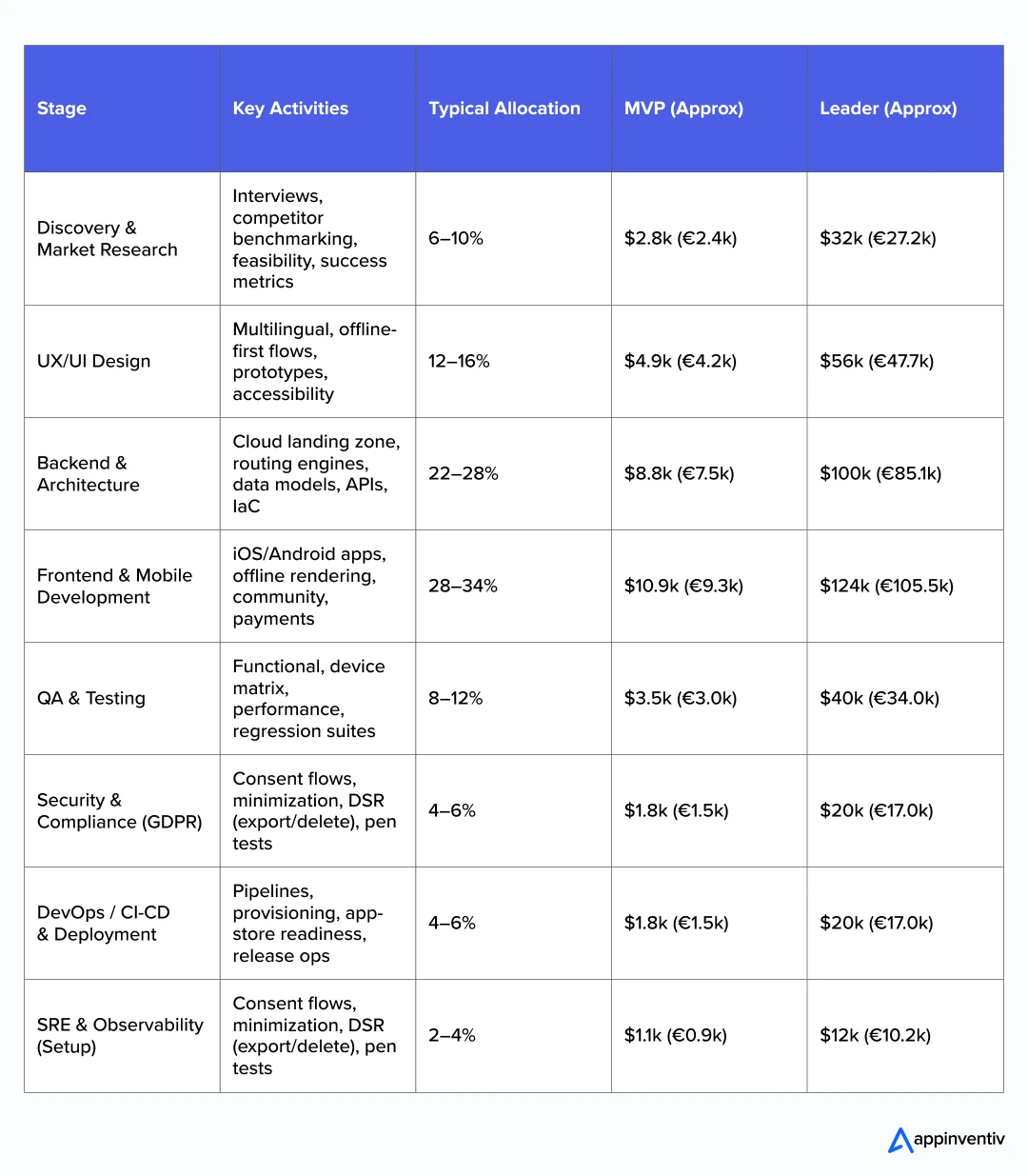
Estimating the Cost
A basic formula can be used to estimate the cost to build route planning app like Komoot, even though every app is different: Here is the route optimization app price estimate based on the features and complexity levels:
- Work Hours: Determined by the stage of development and feature complexity
- Regional differences in developer rates (Western Europe: €70–120/hr, Central/Eastern Europe: €35–60/hr)
- Costs associated with infrastructure and licensing: cloud servers, third-party APIs, and map services
- Costs associated with design/UX: accessibility, offline-first mapping, and multilingual interfaces
- Testing/QA Expenses: Compliance, performance, and functional testing
Cost Estimation Formula
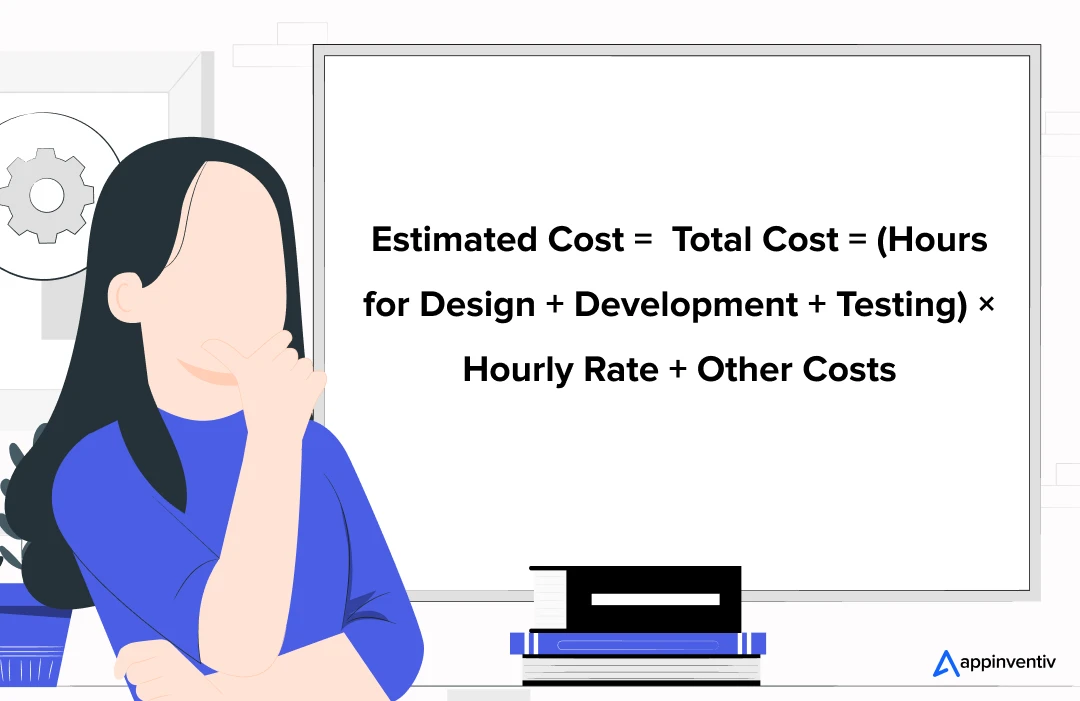
This formula offers a methodical approach when budgeting, also helps in estimating the app development cost while preserving the ability to add more features as needed.
Must Read: How Much Does it Cost to Build an App in the UK
Factors Affecting Cost to Build a Route Planning App Like Komoot
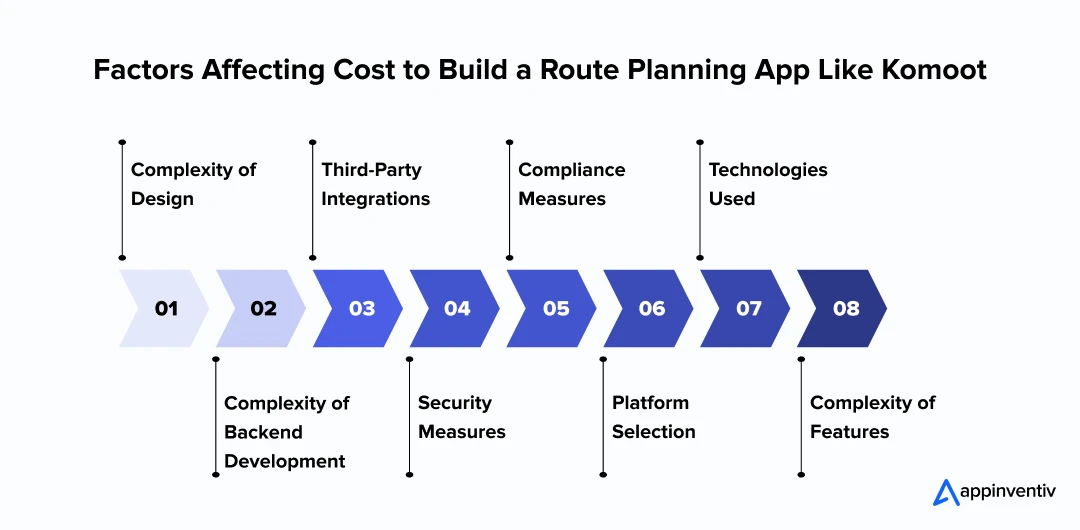
The total investment in developing an app similar to Komoot is determined by a number of important criteria. By being aware of these factors, companies may better plan and allocate resources while making sure the app satisfies the needs of European users.
1. Complexity of Design
A route planning app’s design is more than just its appearance. For European consumers, a user interface that is intuitive, offline-first, and multilingual is essential. Design hours and expenses are increased when supporting several languages (German, French, Spanish, Dutch, and Italian) and making sure that accessibility and cultural alignment are maintained.
2. Complexity of Backend Development
A robust backend is the backbone of any route planning app. Costs rise with the complexity of:
- APIs: Integration with maps, weather, analytics, and social platforms
- Servers & Databases: Scalable cloud infrastructure to handle millions of route requests
- Routing Algorithms: Multi-activity optimization for cycling, hiking, MTB, and running
Backend complexity directly impacts the cost to build a route planning app, particularly for apps aiming for full-featured, leader-tier capabilities.
3. Third-Party Integrations
Integrating additional services adds both time and cost:
- Payment Gateways: SEPA, Bancontact, Sofort for premium region unlocks
- Social Media: Sharing routes and achievements
- GPS & Wearables: Accurate positioning, offline caching, and synchronization with devices like bike computers
4. Security Measures
European users expect strong data protection. Implementing end-to-end encryption, secure authentication, and protection against data breaches increases development costs but is essential for trust and compliance.
5. Compliance Measures
GDPR compliance is non-negotiable for any app operating in Europe. Costs increase when implementing:
- Granular consent management
- Data anonymization and minimization
- Audit trails and user rights (export/delete requests)
Non-compliance can lead to fines up to 4% of global annual turnover, making early investment in compliance a cost-saving measure in the long run.
6. Platform Selection
Deciding between iOS, Android, or cross-platform development affects both performance and budget:
- Native builds offer better offline map rendering and smoother performance for GPS-heavy apps
- Cross-platform frameworks (Flutter, React Native) can reduce initial development cost but may have limitations for advanced mapping and offline features
7. Technologies Used
Advanced technologies add significant value but also cost:
- AI Integration: AI Integration delivers personalized route recommendations by analyzing user history, preferences, and trends, offering smarter, more relevant navigation in real-time.
- AR Overlays: Emerging technology for trail markers, POIs, and scenic landmarks.
- Weather-Aware Rerouting: Dynamic adjustments based on environmental conditions
8. Complexity of Features
The more sophisticated the app, the higher the development effort:
- Offline maps for multiple regions
- Multi-activity routing logic
- Turn-by-turn voice navigation in multiple languages
- Community features (reviews, GPX sharing, gamification)
- Premium subscriptions and region unlocks
Each of these factors adds layers of complexity, increasing both development hours and testing requirements, and therefore directly shaping the Komoot app development cost in Europe.
Navigate design, compliance, and complex features seamlessly. Turn your vision into a scalable, secure, and GDPR-compliant route planning app.
Key Features of Route Planning App Like Komoot
Komoot has established itself as a leader in the route planning app space by leveraging cutting-edge technologies and offering a seamless user experience. Here is the list of key features of Komoot App.
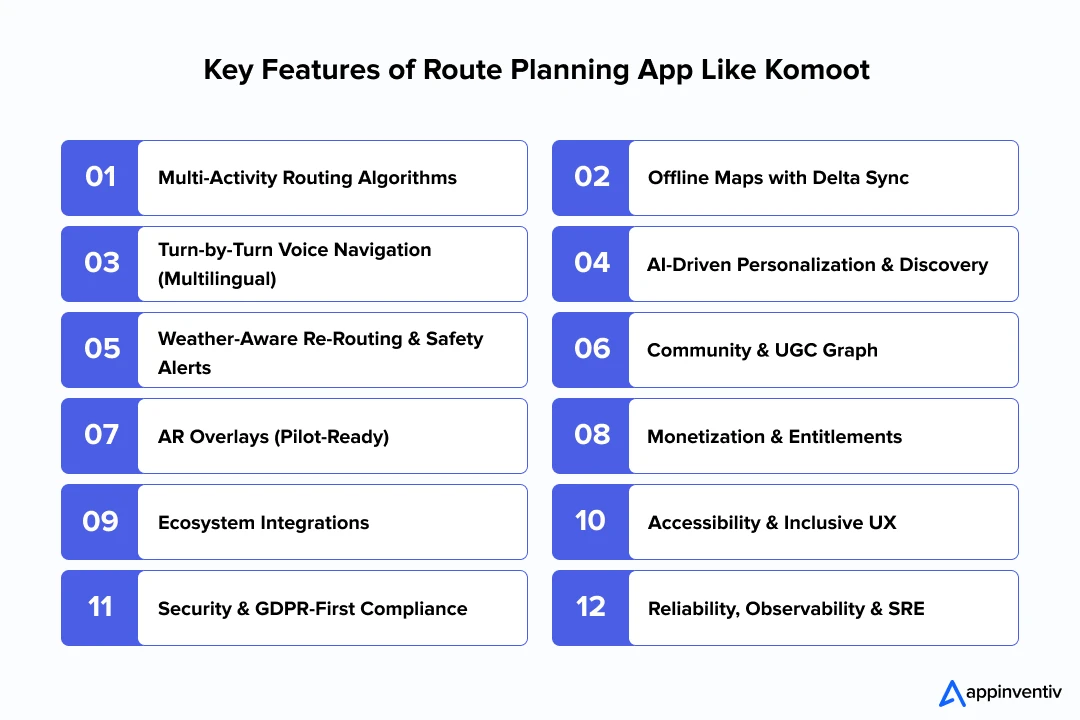
Multi-Activity Routing Algorithms
Compute routes for cycling, MTB, hiking, trail running, and gravel with activity-specific profiles that factor in elevation, gradient, surface type, access rules, seasonal closures, and safety constraints. Use graph algorithms (A*/Dijkstra with Contraction Hierarchies/ALT) plus penalties for stairs, pushing segments, ferries/tunnels, and protected areas to keep routes realistic and safe.
Offline Maps with Delta Sync
Offer downloadable region packs (vector tiles + elevation) that update via small deltas, prefetch along planned routes, and recover gracefully from partial downloads. Apply smart eviction (recency + region priority) to keep storage lean while maintaining reliability in low-connectivity terrain.
Turn-by-Turn Voice Navigation (Multilingual)
Deliver on-device/cloud TTS prompts in 10+ EU languages with lane guidance, off-route detection, and re-route in under ~2–3 seconds. Optimize GPS sampling and background execution for battery life; provide offline fallback voices for remote areas.
AI-Driven Personalization & Discovery
Rank and recommend routes using collaborative and content-based filtering with graph-aware scoring. Blend signals such as past activity, terrain preferences, fitness intent, popularity heatmaps, time-of-day, and seasonality. Default to GDPR-first operation: explicit consent, data minimization, and on-device inference where feasible.
Weather-Aware Re-Routing & Safety Alerts
Ingest real-time and forecast feeds to avoid ice, flood, wind, or closures; apply hazard scoring directly to the routing cost function. Expose user controls for risk tolerance and clearly explain when/why a route changes to build trust.
Community & UGC Graph
Enable GPX import/export, highlights, photos, reviews, and collections with a reputation system and moderation tooling (reports, queues, audit logs) to keep content high-quality. Snap noisy traces to trails, deduplicate near-identical segments, and surface local gems to power discovery.
AR Overlays (Pilot-Ready)
Provide in-camera cues for trail markers, POIs, and hazards on supported devices, with strict safety guardrails: low-distraction UI, quick dismiss, audio alternatives, and offline marker packs for popular parks.
Monetization & Entitlements
Support freemium with region unlocks, subscriptions, and partner content. Integrate EU-preferred payment methods (SEPA, Sofort, Bancontact) alongside app stores; manage trials, refunds, and VAT. Centralize entitlements so access works consistently across devices.
Ecosystem Integrations
Sync with wearables (Garmin, Apple Watch), bike computers, and fitness platforms for activity import/export and richer analytics. Handle rate limits, retries, and privacy-scoped permissions to keep data flows reliable and compliant.
Accessibility & Inclusive UX
Ship WCAG-aligned patterns: high-contrast maps, larger tap targets, dynamic text, configurable haptics, reduced-motion modes, and clear voice prompts. These improve safety and broaden your addressable market across regions and ages.
Security & GDPR-First Compliance
Implement granular consent, purpose-bound data layers, encryption in transit and at rest, data minimization with retention/TTL policies, and automated data-subject rights (export/delete). Maintain DPAs with vendors and audit trails for consent/versioning and incident response.
Reliability, Observability & SRE
Design for weekend/holiday traffic spikes with SLOs (e.g., 99.9% uptime), P95 route retrieval < ~400 ms on popular corridors, autoscaling, and multi-region failover. Use tile/CDN caching and precomputed “hot routes” to reduce egress by ~30–40% and keep performance predictable.
Hidden Costs to Build an App like Komoot
Although the focus is usually on product development, companies usually overlook hidden expenses that have a big influence on the development cost for outdoor navigation apps like Komoot. Resolving these up front guarantees precise budgeting and prevents unpleasant surprises after launch.
1. App Maintenance
Building the app is only the beginning. Ongoing maintenance is critical to ensure reliability, performance, and user satisfaction. This includes:
- Bug fixes and performance optimization
- Regular map updates for accuracy in remote regions
- Updating routing algorithms to accommodate new trails or changes in terrain
- Server monitoring and database management
Maintenance typically accounts for 10–15% of the total development cost annually, making it a significant hidden expense.
Also Read: Understanding App Maintenance Costs in 2025
2. App Hosting
A route planning app like Komoot relies heavily on cloud infrastructure for routing, offline map storage, and real-time updates. Key hosting considerations include:
- Scalable cloud servers to handle millions of route requests
- Content Delivery Networks (CDN) for fast map loading across Europe
- Database storage for user data, GPX tracks, and community content
- Backup and disaster recovery systems to prevent data loss
Hosting costs can vary depending on traffic, storage needs, and regional server locations, but they are essential for providing a reliable, offline-first navigation experience.
3. App Promotion and Marketing
For even the most powerful program to draw users, visibility is necessary. Marketing expenses are essential for adoption but are frequently overlooked in initial budgeting:
- European digital marketing efforts aimed at outdoor lovers
- To increase organic traffic, use SEO and content marketing.
- Community-building activities like contests, tutorials, or rewards for user-generated material
- Influencer marketing and collaboration initiatives with travel bureaus or cycling associations
The expense of developing an app like Komoot is guaranteed to be converted into measurable user acquisition and return on investment with effective promotion.
4. Legal and Licensing Fees
In Europe, where GDPR rules and intellectual property laws are rigorously enforced, compliance and licensing are essential. In this area, hidden costs include:
- Audits and consulting related to GDPR compliance
- Licensing geographic datasets and map APIs (such as OpenStreetMap and third-party trail maps)
- Creation of privacy policies and terms of service
- Protecting and registering trademarks for app branding
Although they might not seem important, legal and licensing fees can have a direct impact on the total cost of developing a route planning app by causing fines or delayed launches.
Ways to Optimize Komoot-like App Development Costs
Developing a high-quality route planning app like Komoot can be a significant investment, but there are strategic ways to optimize the cost without compromising on quality or user experience. Following are the ways to build an app like Komoot.
1. Developing an MVP
One of the most effective ways to manage app development costs is to start with a Minimum Viable Product (MVP). Focus on core features that address immediate user needs, such as:
- Offline maps for select regions
- Real-time GPS navigation
- Multilingual support
- Basic community features
Getting your app out early matters more than perfecting every feature. Start with a Minimum Viable Product (MVP) — something lean but usable — so you can test the idea in the real world without tying up too much budget. If users respond well, that’s the time to bring in bigger pieces like AI personalization, AR layers, or subscription models.
Budget ballpark: An MVP for an app similar to Komoot in Europe usually falls between $30k (€25.5k) and $40k (€34k),. The exact number depends on how big the team is and how complex the first version gets.
2. Leveraging Cross-Platform Development
Choosing the right technology stack can significantly reduce development effort. Cross-platform app frameworks like Flutter or React Native allow you to build both iOS and Android apps simultaneously, cutting time and cost compared to fully native builds.
- Suitable for offline-capable apps with moderate real-time updates
- Reduces duplicate development and testing efforts
Cost impact: Cross-platform development can lower the cost to build a route planning app by up to 20–30%, while still providing a robust user experience.
3. Outsourcing to Cost-Effective Regions
Developer rates vary widely across Europe. By combining Western Europe oversight with execution in Central and Eastern Europe, businesses can reduce costs without compromising quality.
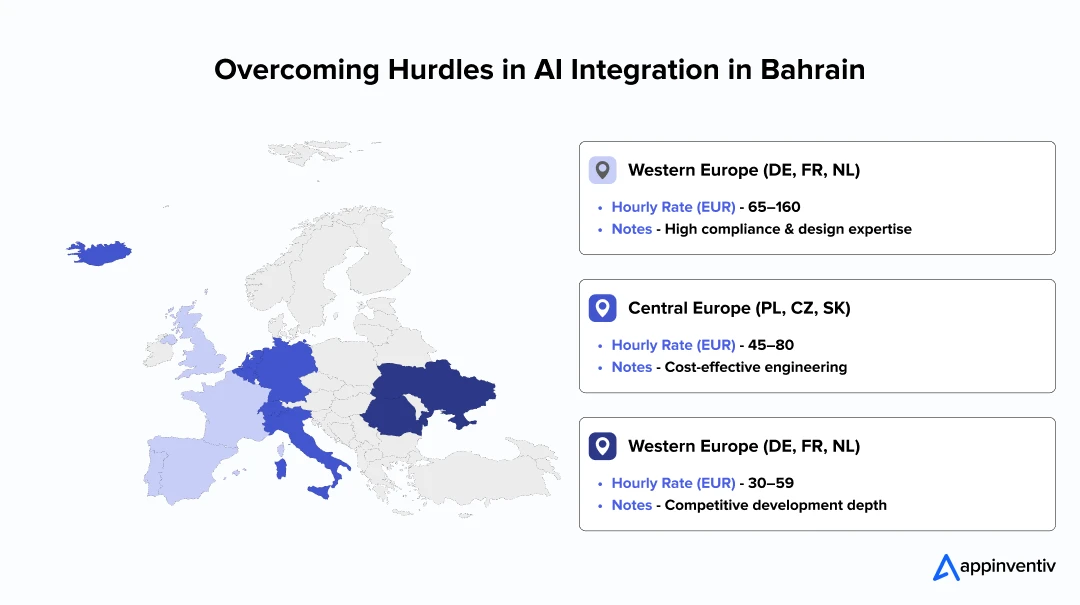
Outsourcing or hybrid models allow you to maintain European compliance and high UX standards while controlling the overall Komoot app development cost.
Steps to Build an App like Komoot
Building a solid route-planning app like Komoot isn’t about rushing into code. It’s about moving step by step balancing what users actually need, the complexity you can afford, and the rules you have to follow in Europe. The process will look a little different for every team and budget, but most successful builds start the same way:
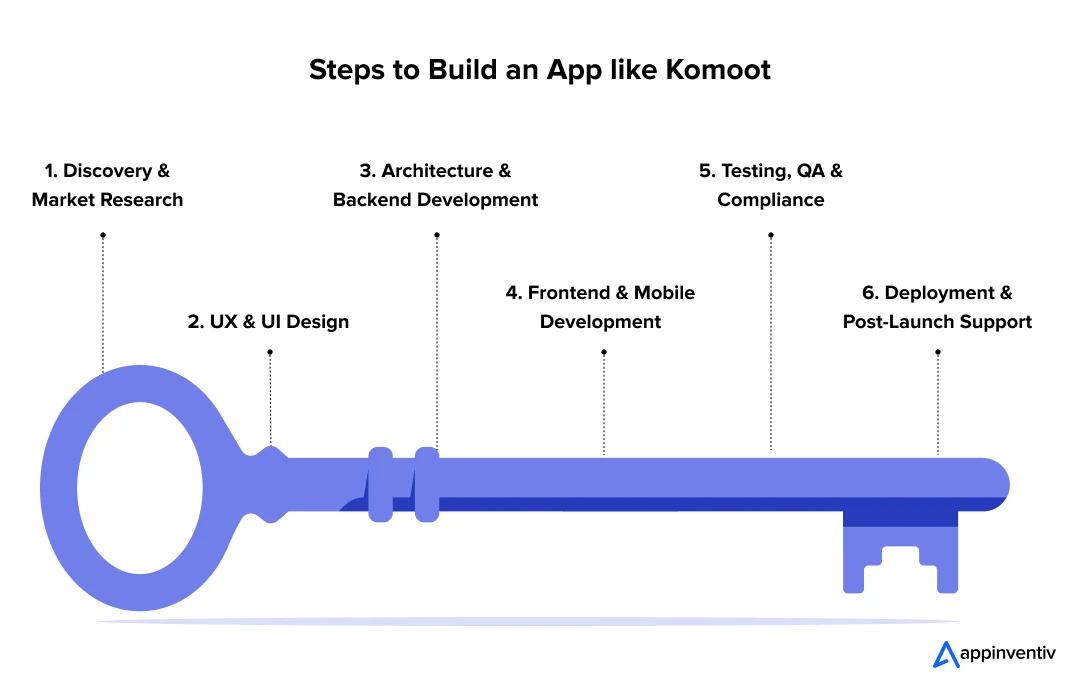
1. Discovery & Market Research
Before committing build budget and sprints, map Europe’s outdoor navigation landscape and precisely define the customer segments you’ll serve. Check what’s working for competitors such as Komoot, Strava, and Outdooractive – not to copy, but to learn where there’s still room to stand out.
- Talk to users: Cyclists, hikers, and outdoor explorers. Interview them, run small surveys, and watch how they plan their routes. See what frustrates them and what they wish worked better.
- Benchmark competitors: Map out the features, pricing models, and growth tactics of top players. Look for gaps or angles they’re missing.
- Test the tech: Explore map APIs, offline routing options, and any third-party data you’ll need for accurate and reliable routes.
Spending real time here helps you avoid scope creep later and gives you a clear picture of what building something “Komoot-level” will really cost.
2. UX & UI Design
Design can make or break your app. People stay when it feels easy and familiar, especially across Europe where users speak different languages and have different outdoor habits. Think about:
- Language first: Don’t just stick to English. Add support for German, French, Spanish, Dutch, Italian — at least the major ones.
- Helpful suggestions, not noise: Use AI to suggest routes that fit the weather, local popularity, how hard the path is, and what someone’s done before.
- Beyond hiking and cycling: If you can, build for things like gravel biking, snowshoeing, trail running. Each one adds a small but loyal audience.
- Real community feel: Give people ways to swap routes, plan trips with friends, set up challenges. Sharing keeps users coming back.
- Safety in the moment: Use AR or clear overlays to show trail hazards, turns, or points of interest right where they stand.
- Stay adaptable: If the weather turns or a trail closes, reroute them quickly.
- Pay options that make sense: Start free to hook people, then add local subscriptions or partner with travel networks for extras.
Design like this doesn’t just look good — it earns trust and keeps people opening the app again and again.
3. Architecture & Backend Development
The backend forms the backbone of the app. Key tasks include:
- Cloud Infrastructure: Scalable servers to handle millions of requests
- Routing Algorithms: Multi-activity routing logic optimized for performance
- Database & Caching: Offline map storage and personalized route recommendations
- API Integrations: Weather, maps, analytics, and wearable devices
4. Frontend & Mobile Development
Develop responsive, offline-capable mobile apps across iOS and Android. Considerations:
- Offline map rendering and smooth navigation interactions
- Community features like GPX sharing, reviews, and highlights
- Payment stack for premium regions and subscriptions
- Cross-platform frameworks like Flutter or React Native can reduce cost, but native builds may be preferred for high-performance navigation
5. Testing, QA & Compliance
Quality assurance is critical for navigation apps:
- Functional testing across devices
- Offline map reliability and routing accuracy
- GDPR compliance testing (consent flows, data protection)
- Beta testing with local users in target European regions
6. Deployment & Post-Launch Support
Launching the app is just the beginning. Post-launch activities include:
- Monitoring server performance and load balancing
- Analytics tracking for route usage and feature adoption
- Rolling out map updates and bug fixes
- Continuous GDPR compliance audits
From MVP to full-scale route planning apps, our team guides you step by step — balancing user needs, compliance, and growth. Your idea deserves a trusted partner.
Best Ways to Make an App Better than Komoot
In order to create an app that performs better than Komoot, UI/UX, feature set, and underlying technology must be strategically improved. Delivering a better user experience, more functionality, and greater market distinctiveness are the objectives, all while effectively controlling the cost of developing an app similar to Komoot.
UI/UX Enhancements
- Experience First Offline: By increasing map rendering speed, storing a wider area, and facilitating smoother transitions even in places with poor connectivity, you may go beyond simple offline maps.
- Multilingual UX: To increase acceptance in fragmented markets, multilingual and localized design should support more European languages (15+) and take into account local cultural preferences.
- Accessibility & Intuitive Navigation: To guarantee usability for all users, incorporate accessibility compliance, advanced gestures, and route previews.
- Personalized Dashboards: Display activity-specific statistics, recent itineraries, and suggested trails according to user behavior on personalized dashboards.
2. Feature Enhancements
- AI-Powered Recommendations: Provide routes based on weather, popular local trails, past activity, and preferred level of difficulty.
- Advanced Multi-Activity Routing: Use terrain-specific optimizations to expand the routing logic to incorporate specialized activities like snowshoe hiking or gravel biking.
- Community-Driven Content: To improve user stickiness, include more tools for social sharing, group route design, and gamified challenges.
- AR Trail Overlays: Provide safety alerts, trail directions, and augmented reality markings for sites of interest.
- Safety & Weather-Aware Rerouting: Include dynamic rerouting in case of unforeseen weather conditions, road closures, or trail dangers.
- Premium Unlocks & Flexible Monetization: Provide freemium access, region-based subscriptions, or joint ventures with regional travel bureaus and transportation systems.
3. Technological Advancements
To stand out and keep users coming back, the tech behind your app has to be both smart and dependable. Here’s what matters most:
- Machine learning that respects privacy: Build recommendation systems that adapt to each user’s habits- but stay fully GDPR compliant with consent controls and safe data handling.
- Fast, scalable backend: Design your cloud setup to handle millions of European users at once without slowing down.
- Cross-platform done right: Pick the right framework- native if you need heavy offline map rendering and top performance, or Flutter/React Native if speed and cost matter more.
- Wearable and platform integrations: Connect with smartwatches, bike computers, Garmin, Strava and similar tools to give users a richer picture of their activities.
- Security built in: Use end-to-end encryption, anonymized tracking, and clear consent flows to protect user data and meet GDPR rules.
Strong, modern tech doesn’t just add features- it builds trust and keeps people engaged long-term, which is especially important in the European market.
Leveraging advanced technologies not only improves functionality but also enhances user trust and engagement, which is critical in the European market.
How Appinventiv Built an App Like Komoot
Our specialty at Appinventiv is creating top-notch route planner apps specifically for the European market. Our strategy for developing an app similar to Komoot was to combine technological know-how with strategic insight, guaranteeing GDPR compliance, scalability, and cost effectiveness.
Solutions and Services Offered
- Adaptable Teams: Dedicated designers, developers, and quality assurance professionals scaled from MVP to fully functional solutions in accordance with project needs.
- Core Features: AI-driven route recommendations, turn-by-turn navigation, offline maps, multi-activity routing, and community features are all examples of feature implementation.
- GDPR-First Architecture: Made sure that European privacy laws were followed right away.
- Market-Informed Decisions: Advice on features that appeal most to European users, cutting down on wasteful development expenditures.
- Iterative Delivery: Agile development methods leverage iterative delivery to test features, get user validation, and continuously maximize return on investment.
Results Achieved
- Scale & Reliability: Reached 1.2M+ MAU with 99.95% uptime; crash-free sessions >99.8%.
- Performance: P95 route retrieval <300 ms on top EU corridors; offline pack install success >97%.
- Engagement: Route completion rate +21–28%; 90-day retention +12–18% after community and personalization releases.
- Monetization: Free-to-paid conversion +3–6 pp; ARPU uplift +12–15% via regional unlocks and subscriptions.
- Cost Efficiency: Map-tile egress −35–45% through delta updates/CDN tuning; infra cost per active user −25–30% with storage tiering and autoscaling.
- Localization: Launched in 12 EU languages, expanded to 18 within two releases; locale-specific paywalls lifted conversion +8–11% in DACH/BeNeLux.
- Privacy & Compliance: 100% consent logged and auditable; DSAR (export/delete) median turnaround <48 hours; data retention policies reduced PII footprint −40%.
- Trust & Ratings: App store rating +0.4–0.6 points post-stability and battery optimizations; NPS +10–14.
- Operations: Incident MTTR <30 min with on-call runbooks; automated regression suites cut release cycle time −35%.
Monetization Strategies for Route Planner App Development
Building a Komoot-like app is a significant investment, but the right monetization strategy can offset costs and drive sustainable growth.
Freemium Model with Regional Unlocks
- Users access basic routing for free, while premium features like offline maps for multiple regions or advanced activity routing require payment.
- Why it works in Europe: European users prefer trying core functionality before committing financially.
- Impact on cost to build an app like Komoot: Implementing in-app purchases and region-based pricing adds modest development complexity but significantly improves ROI.
Subscription-Based Access
- Monthly or annual subscriptions unlock features such as:
- Unlimited access to premium maps
- Personalized recommendations and AI-assisted routing
- Integration with wearables and activity trackers
- Revenue advantage: Provides predictable cash flow to justify investments in advanced features.
Strategic Partnerships and B2B Collaborations
- Collaborations with tourism boards, cycling associations, local governments, and businesses. Examples include:
- Sponsored routes and premium content for specific regions
- Integrated ticketing or mobility solutions
- Featured recommendations for restaurants, accommodations, and adventure activities
- Benefit: Generates revenue while boosting user adoption, aligning with the Komoot app development cost Europe considerations.
Contextual, GDPR-Compliant Advertising
- Contextual ads for local experiences, cycling gear, or travel services, fully GDPR-compliant.
- Benefit: Adds a revenue stream without compromising user trust.
Marketplace Model
- A marketplace for premium content, guided tours, or activity bookings.
- Users pay for curated experiences or equipment rentals, with the app taking a commission.
- Benefit: Supports scaling without proportionally increasing the cost to build an app like Komoot.
How to Choose the Right Partner to Build App Like Komoot Cost in Europe
The cost to build an app like Komoot isn’t just about developer rates; it’s about efficiency, compliance, and scalability. A strong partner helps with:
- Proven domain expertise: Companies seeking expertise in route planner app development or similar navigation solutions benefit from partners with proven experience. These partners understand the complexities of routing algorithms, offline maps, and multi-modal navigation, ensuring seamless and efficient solutions.
- Transparent pricing model: To accurately manage the Komoot app development cost in Europe, your partner should provide clear estimates with breakdowns by development stages, region-wise rates, and feature complexity.
- End-to-end capabilities: From discovery and UX/UI design to backend architecture, integration, testing, and deployment, a full-stack partner minimizes overhead and helps in optimizing the cost of developing apps like Komoot.
- Agile and iterative delivery: European markets evolve rapidly. Partners who adopt agile methodologies allow you to launch faster, validate features, and iterate — avoiding costly rewrites or delays.
This is where Appinventiv stands out. We have delivered scalable navigation apps, optimized development cost for outdoor navigation apps, and ensured compliance with European laws while maintaining user trust.
Why Partner with an App Development Company like Appinventiv
At Appinventiv, we’ve spent years helping companies launch reliable transportation apps like TrackMyShuttle and route-planning apps. We know the Europe region’s mix of languages, privacy laws, and outdoor culture can make development tricky. That’s where a clear build strategy matters as much as the code itself.
What really drives cost:
Things like feature depth, local developer rates, GDPR compliance, and how much you want to scale will shape the budget. Without planning, costs can creep fast. Our job is to keep that from happening while still building something people want to use.
Here’s how we work:
- Real navigation know-how: We’ve delivered apps with offline maps, AI suggestions, and social route sharing. They’re fast, stable, and built for outdoor users.
- Transparent pricing: No vague ranges. We break costs by stage and feature so you can decide where to invest and where to wait.
- Privacy built in: GDPR isn’t bolted on later. We plan for it from the start — consent flows, encryption, safe data use.
- One partner, full build: Research, design, backend, testing, launch — we handle it end to end so you don’t juggle vendors.
- Iterate early: We deliver and test in small steps. If something’s not working, you find out before it’s expensive to fix.
- Market insight: Our team tracks what outdoor users in Europe care about and helps you pick features that will actually stick..
We have worked with over 1,600 clients, ranging from startups to Fortune 500 companies, and developed 2,000+ mobile apps across 70+ countries. As a mobile app development company based in Germany, and with a presence across Europe, we follow an agile process that ensures you’re involved at every step. Our expertise ensures your app is both practical and future-ready, tailored to meet the needs of the local audience.
With Appinventiv, you’re not just building an app. You’re gaining a partner who knows how to design, scale, and localize route-planning tech that fits Europe’s unique outdoor culture and strict GDPR standards. Together, we’ll turn your vision into the next Komoot-level success.
FAQs
Q. How much does a Komoot-like app cost to build?
A. The cost to build an app like Komoot varies depending on complexity:
- MVP (Minimum Viable Product): $30k–$40k (€25.5k–€34k) $193K–$374K
- Growth Stage: $481K–$963K $40k–$400k (€34k–€340.3k)
- Leader Tier: $400k+(€340.3k+) $1.07M–$2.35M
Q. How long does it take to build an app like Komoot?
A. These durations depend on feature complexity and team size. Development timelines are as follows:
- MVP: 4–6 months
- Growth Stage: 6–10 months
- Leader Tier: 9–18 months
Q. What advantages come with developing an app similar to Komoot?
A. Developing a Komoot-like app offers:
- Access to a growing market: Outdoor tourism, including cycling, is projected to exceed €44 billion annually in Europe.
- Scalability: Begin with core features and expand as user demand grows.
- Monetization opportunities: Implement freemium models, regional unlocks, and subscriptions.
- GDPR compliance: Ensures user data protection, fostering trust.
Q. Why should you choose us to build an app like Komoot?
A. Partnering with Appinventiv provides:
- Expertise: Proven experience in developing route planning apps tailored for the European market.
- GDPR-first approach: Ensuring compliance from the outset.
- End-to-end services: From discovery and design to deployment and maintenance.
- Agile methodology: Facilitating iterative development and timely delivery.
Q. How can you monetize an app like Komoot?
A. Monetization strategies include:
- Freemium model: Offer basic features for free; charge for premium functionalities.
- Region-based unlocks: Allow users to purchase access to specific areas.
- Subscription plans: Provide monthly or annual access to advanced features.
- Partnerships: Collaborate with tourism boards or local businesses for sponsored content.
Q. What factors influence the cost of building a route planning app?
A. Key factors include:
- Feature complexity: Advanced functionalities like AI personalization or AR overlays increase costs.
- Design requirements: Multilingual support and offline-first interfaces add to development time.
- Platform choice: Native vs. cross-platform development impacts budget.
- Developer rates: Vary by region; for instance, Eastern Europe offers competitive rates.
- Compliance needs: Ensuring GDPR adherence may require additional resources.
Q. What features add to the cost of route planner app development?
A. Features that increase development costs include:
- Offline maps and navigation: Essential for remote areas.
- AI-powered recommendations: Personalizes user experience.
- Augmented Reality (AR) overlays: Enhances user interaction.
- Multi-activity routing: Supports various outdoor activities.
- Community features: Enables GPX sharing, reviews, and gamification.
Q. Where can I find affordable route planning app developers in Europe?
A. Affordable developers can be found in:
- Eastern Europe: Countries like Romania and Ukraine offer competitive rates.
- Central Europe: Poland and the Czech Republic provide cost-effective solutions.
- Western Europe: While more expensive, countries like Germany and the Netherlands offer high-quality development.


- In just 2 mins you will get a response
- Your idea is 100% protected by our Non Disclosure Agreement.
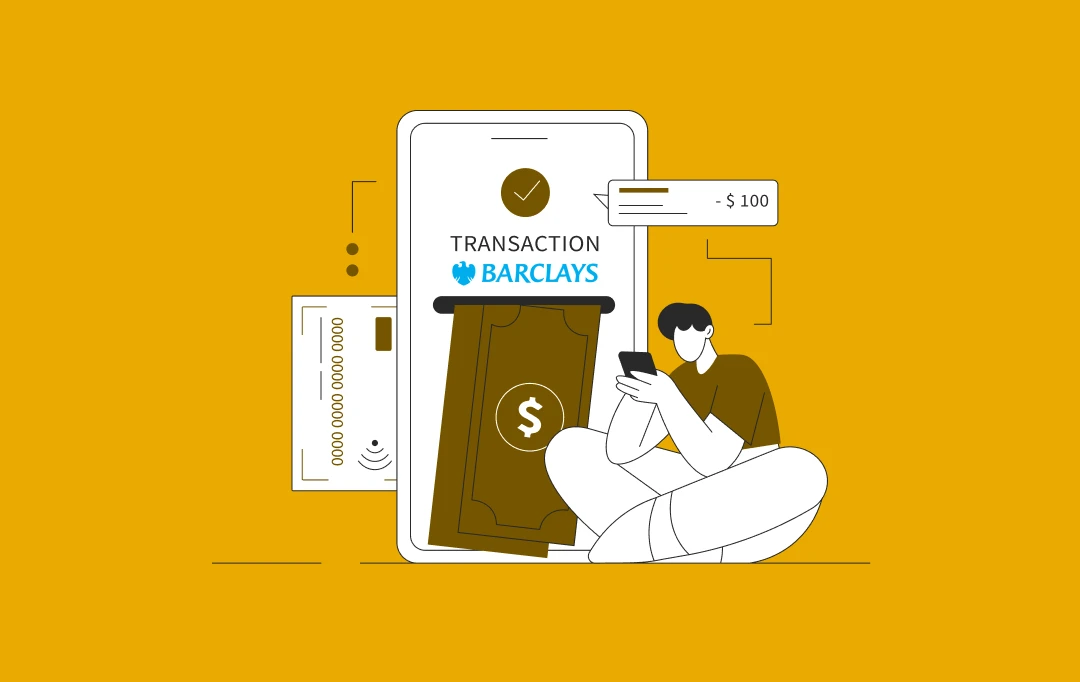
How Much Does It Cost to Build a Banking App like Barclays?
Key takeaways: Barclays sets the bar: Its speed, security, and money management tools show what EU users expect from modern banking apps. Costs vary a lot: A basic, compliant app can start around $40,000 (≈€30,000), while a feature-rich build can reach $400,000+ or more (≈€298,000+). Rules add real work: Meeting PSD2, GDPR, and instant payment…

How Much Does It Cost to Build an App in Egypt?
Key takeaways: The cost to build an app in Egypt starts at 1,485,000 EGP for an MVP and can scale beyond 29,700,000 EGP for enterprise solutions, complexity being the biggest driver. The cost of mobile app development in Egypt is shaped by multiple factors: tech stack, UI/UX depth, backend infrastructure, integrations, and compliance needs. Viewing…
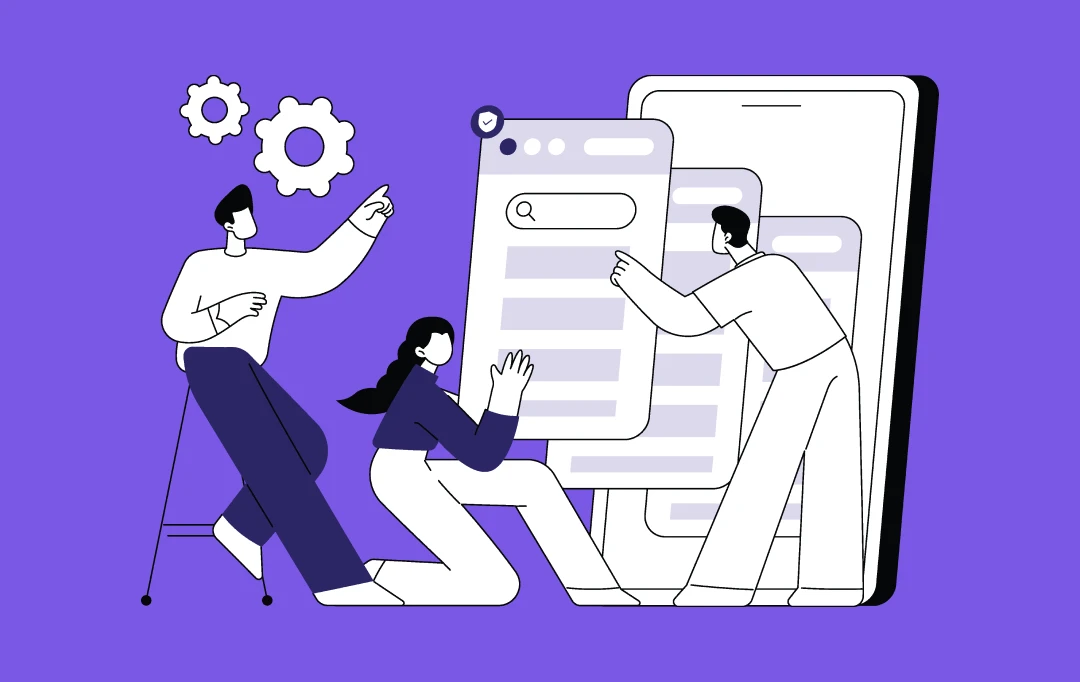
How Much Does It Cost to Build a Safety Observation App?
According to the International Labour Organization, workplace-related deaths exceed the average annual deaths from road accidents (999,000), war (502,000), violence (563,000), and HIV/AIDS (312,000). An estimated over 2.78 million workers die from work-related accidents annually, with economic losses reaching $2.8 trillion globally. This staggering reality has widened the eyes of organizations and compelled them to…











